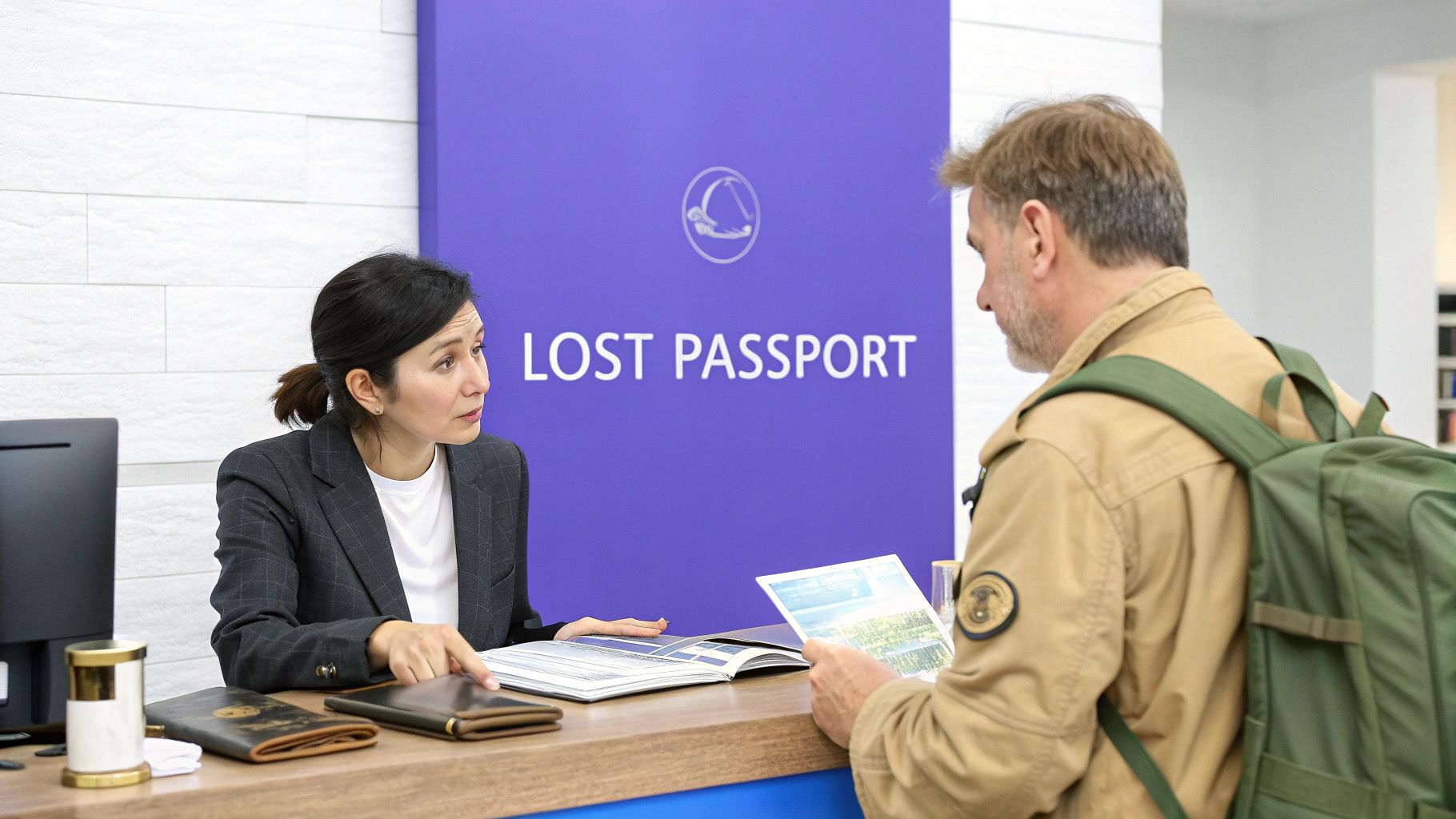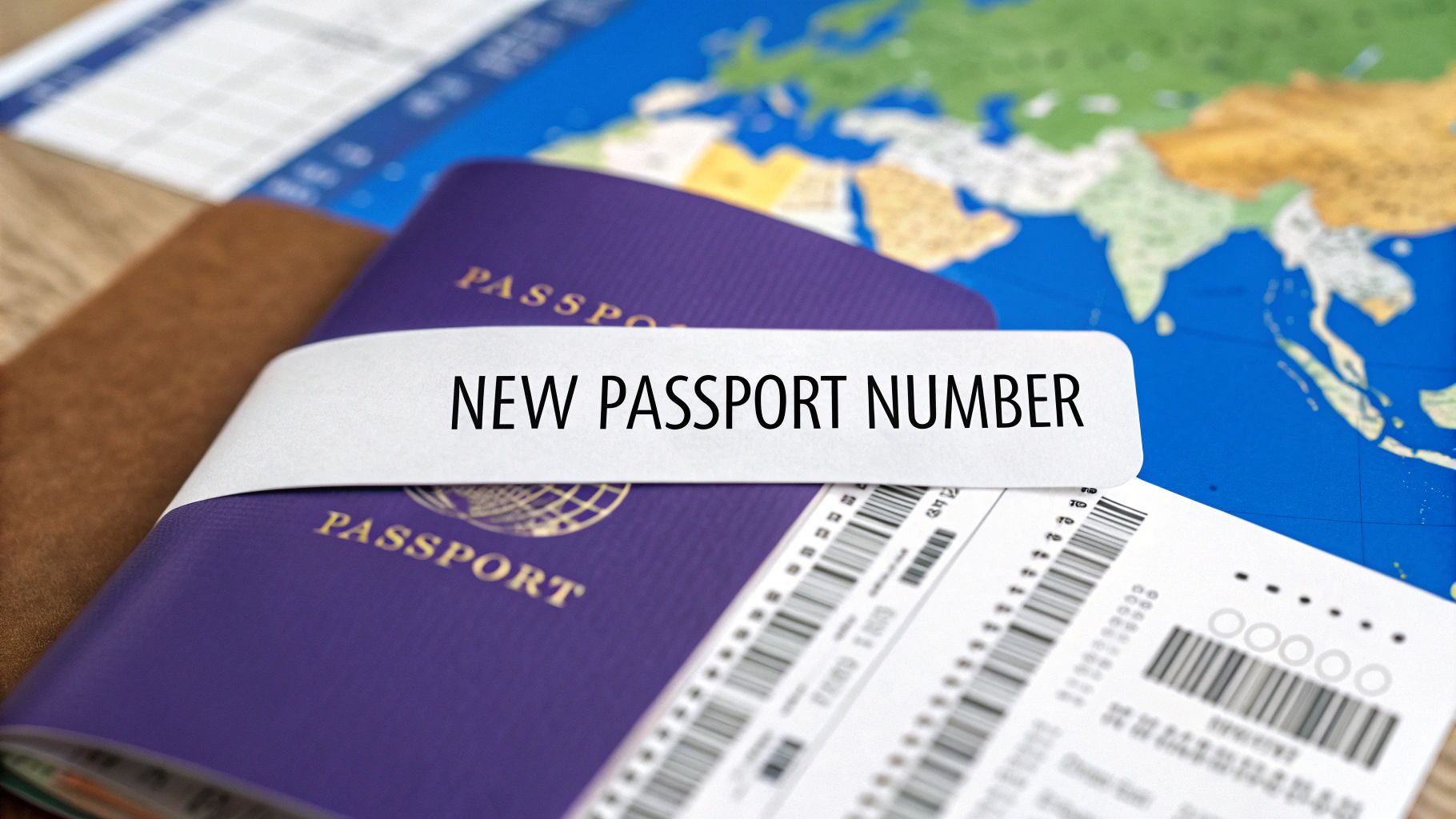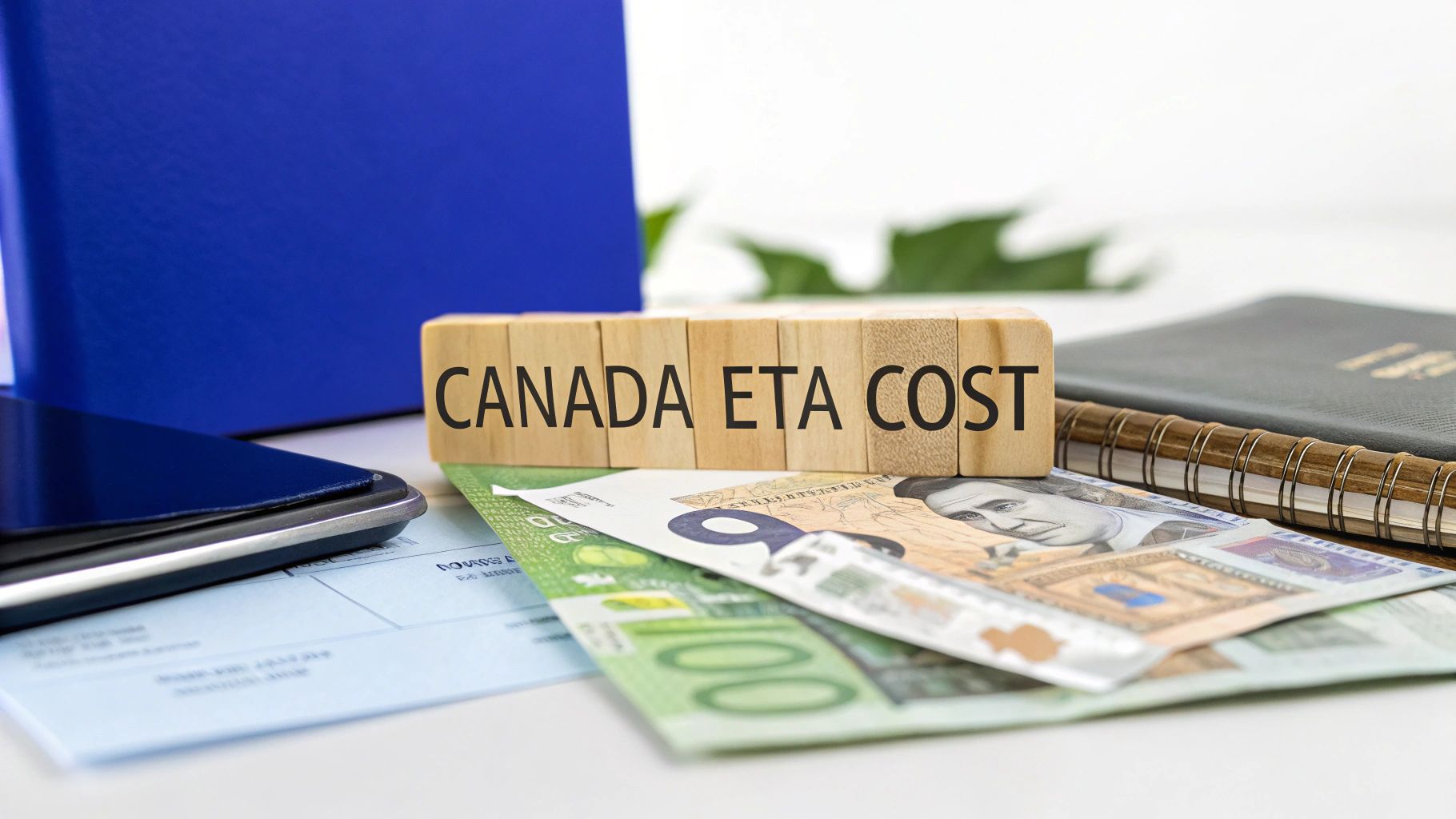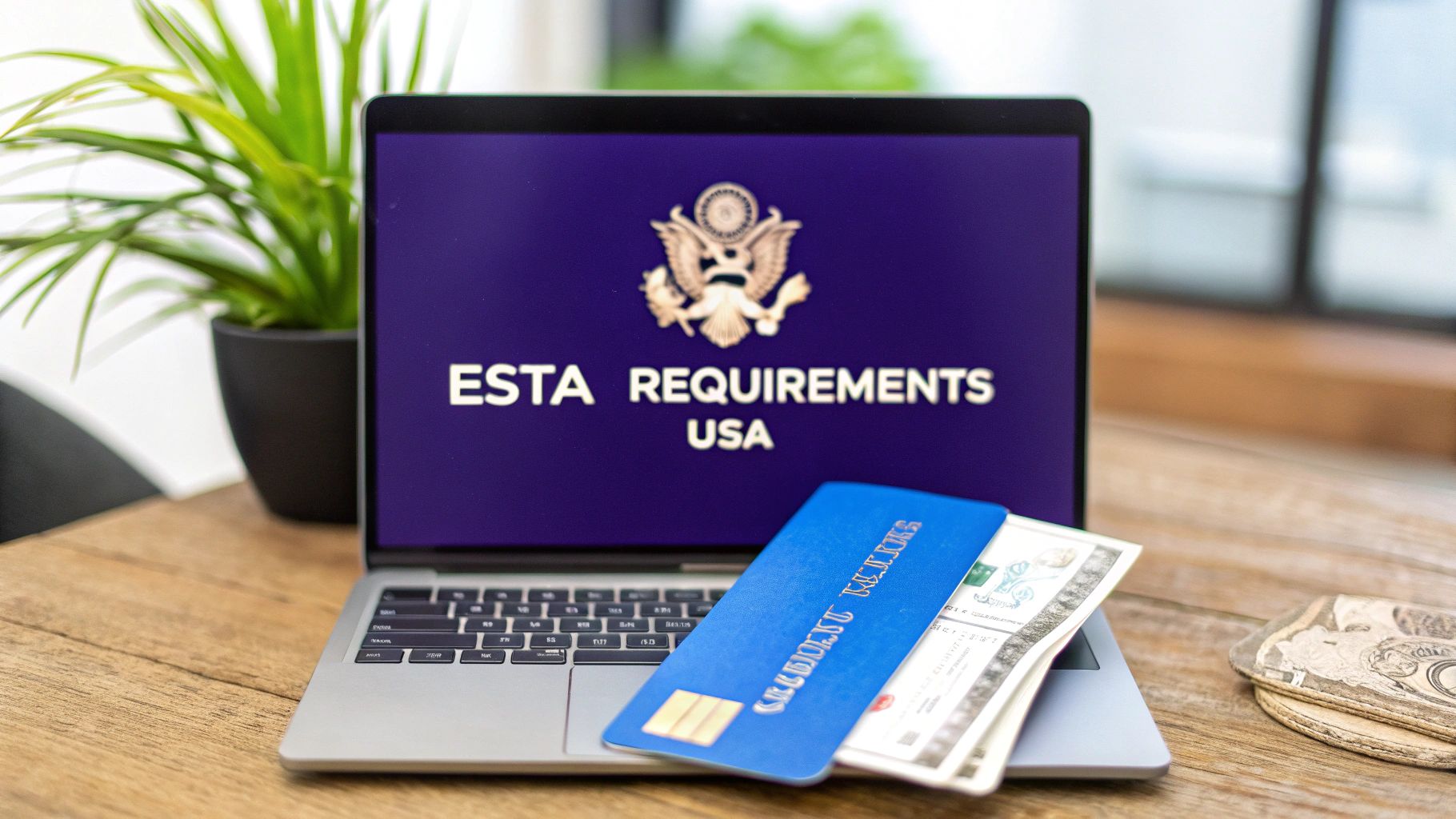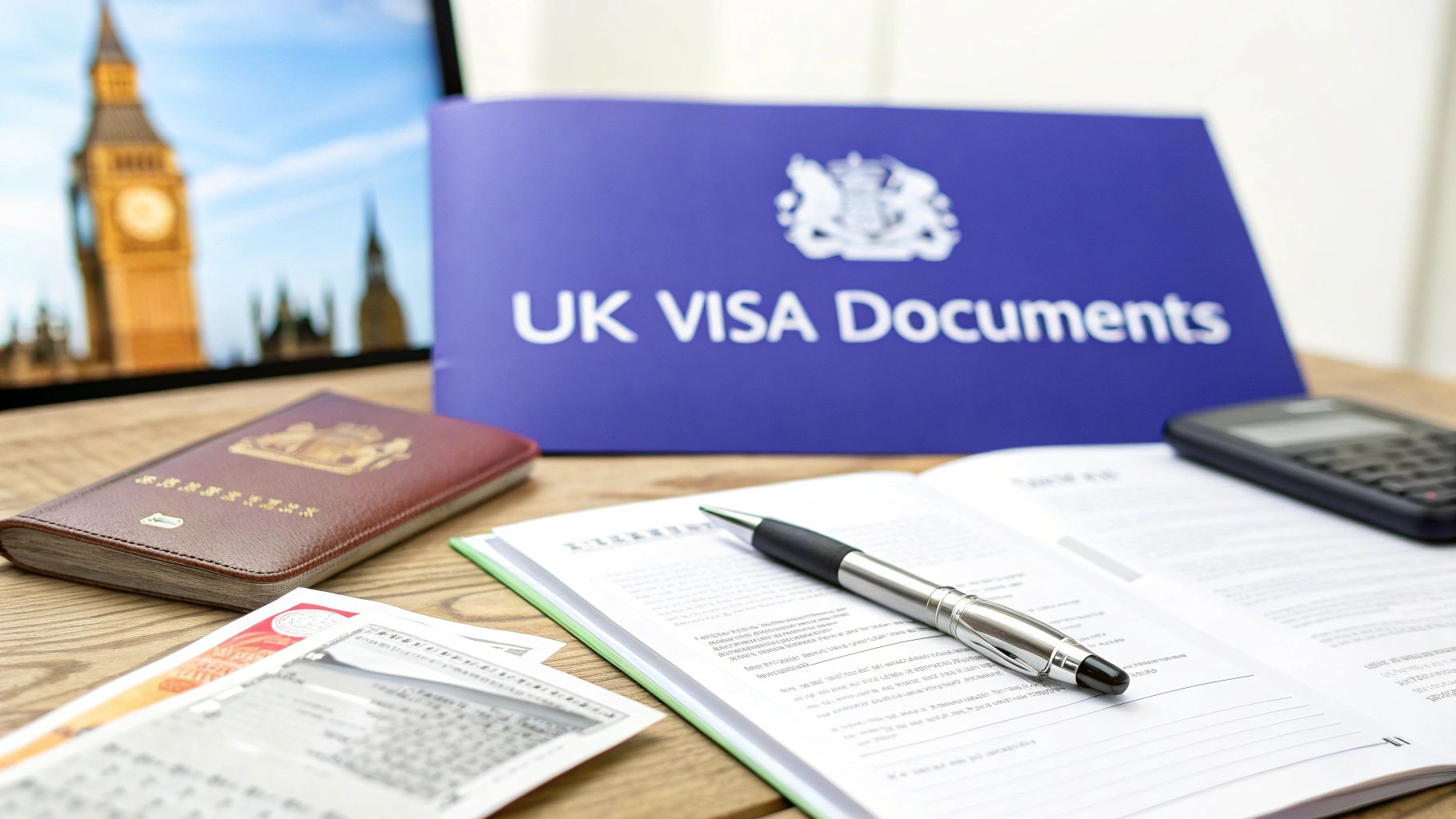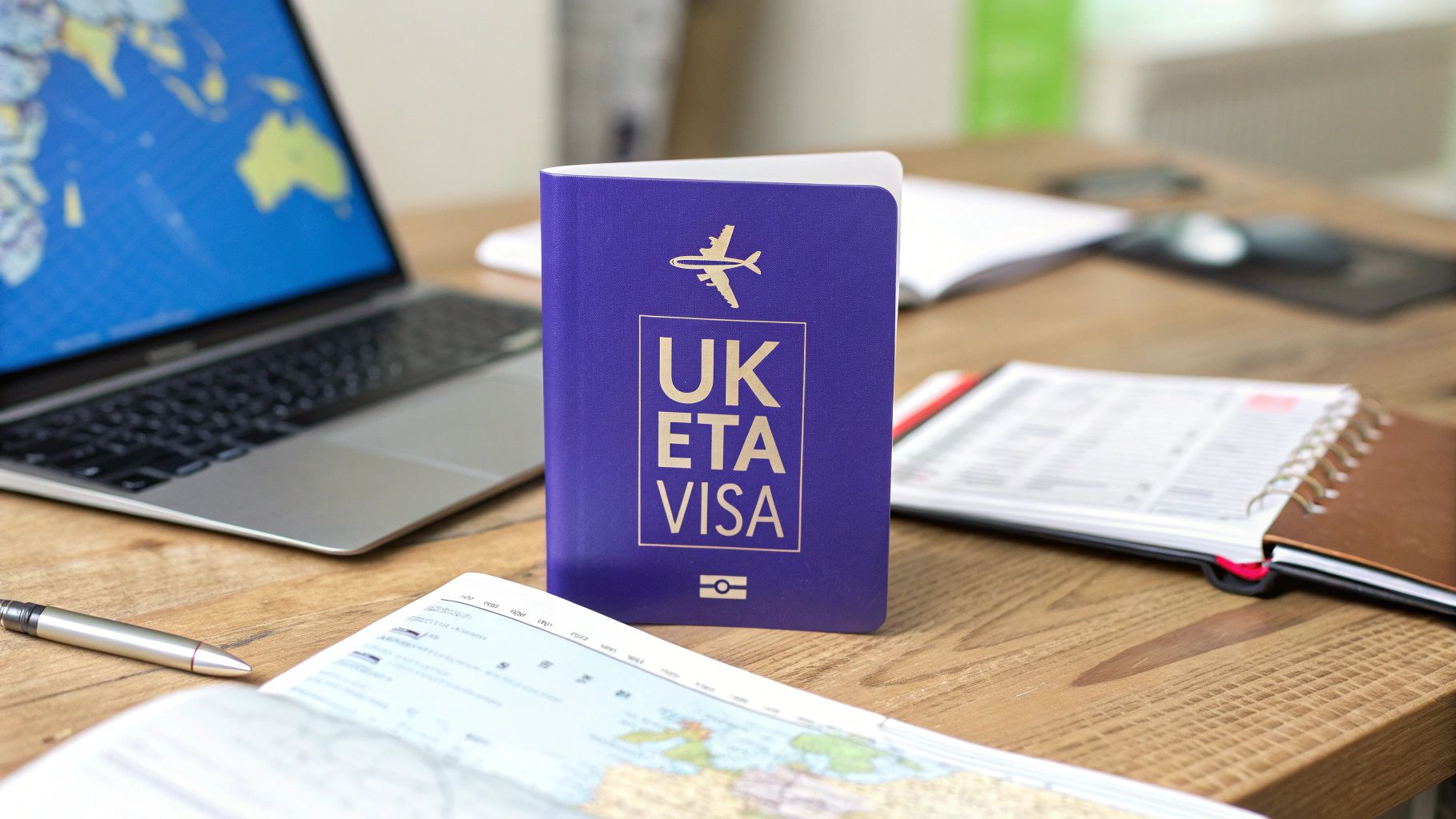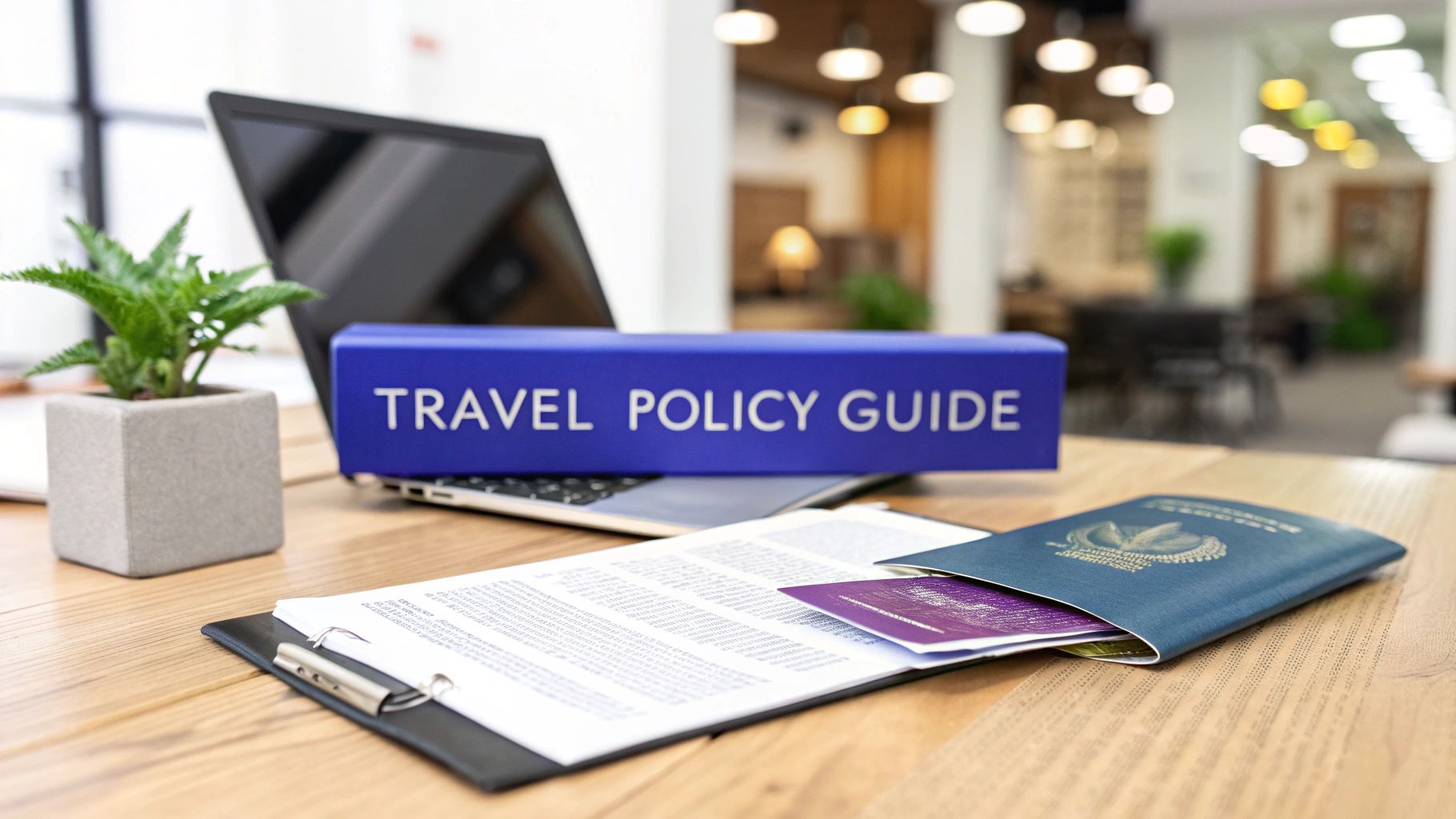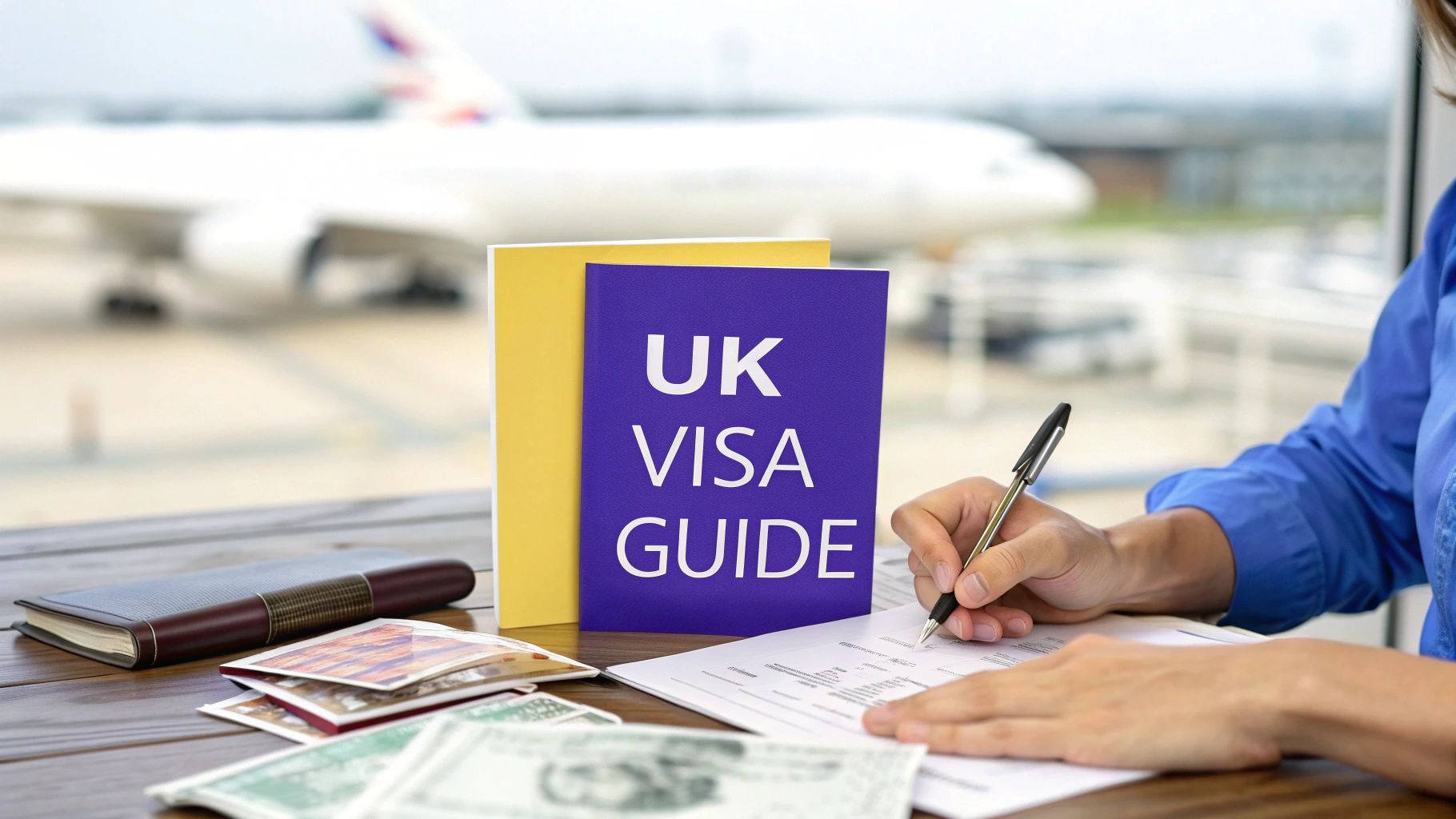
Your Guide to the UK Tourist Visa Form: The New ETA Explained
If you're planning a trip to the UK and don't need a full visa, you'll likely be dealing with the Electronic Travel Authorisation (ETA). Think of this as the new "UK tourist visa form" for many nationalities. It’s a completely digital system that has replaced the old, often clunky paper-based processes with a straightforward online application for your travel authorization for UK.
Getting to Grips with the New UK ETA
The way we prepare for a trip to the United Kingdom has changed. For a lot of us, the days of lengthy visa applications are over, thanks to the much simpler UK ETA system. This is all part of the UK’s big push to digitize its borders, making travel smoother for tourists while tightening up security.
It's important to understand that an ETA is not a visa. It's simply a permission to travel. Getting one means you've been pre-cleared to board your flight or another transport to the UK.
The system is being introduced in phases. Soon enough, almost anyone who could previously visit the UK for a short trip without a visa will need an ETA. This includes travelers from the US, Canada, Australia, New Zealand, and all across Europe.
Why the Big Change to a Digital System?
At its core, the move to the ETA is about security. Pre-screening visitors before they even get on a plane helps the UK government spot potential issues early. It also brings the UK's border process in line with systems you might already be familiar with, like the ESTA for the United States or Canada's eTA.
For us travelers, this new approach has some real advantages:
- It’s Fast: Most applications get a decision within three working days, and many come back even faster.
- It’s Convenient: You can do it all from your couch. No more trips to a visa application centre.
- It’s Cheaper: The application fee for an ETA is significantly lower than what you'd pay for a standard visitor visa.
This kind of policy shift isn't new, and it always has an impact. We see it time and again—when the government adjusts immigration rules, travel patterns change. Just look at what happened when they raised the family visa income requirements in April 2024. Monthly applications in that category plummeted from 12,700 to 5,100 by June 2024. It’s a stark reminder of how sensitive travel plans are to new rules. You can dig into these figures yourself in the monthly entry clearance applications data.
The Bottom Line: For most visa-exempt travelers, the UK ETA application is now the essential first step. It's a mandatory pre-travel check that makes your arrival in the UK more predictable and secure.
While the process itself is designed to be simple, getting the details right is absolutely critical. A small mistake on your UK ETA application can cause annoying delays or even get your application denied, which could throw a major wrench in your travel plans. Double-check everything before you hit submit—a few extra minutes of care can save you a world of trouble.
Getting Your Paperwork Ready for a Flawless Application
Honestly, a successful application is won or lost before you even open the official form. The single best thing you can do to make this process painless is to get all your documents and information sorted out first. Trust me, diving in unprepared is a surefire way to get frustrated and make mistakes.
Before you start, just take a few minutes to gather everything you'll need. This simple prep work saves you from that annoying dance of starting the form, stopping to hunt for some piece of information, and then worrying the page will time out.
The Absolute Must-Haves
Let's start with the basics. Think of these as your non-negotiables for the UK ETA application. Without them, you're not going anywhere.
- Your Valid Biometric Passport: This needs to be from an ETA-eligible country. Check the expiration date—it must be valid for at least six months beyond the day you plan to arrive in the UK.
- A Good Digital Photo: You'll need a clear, recent, passport-style photo. The UK government is strict about this, so make sure it meets their official standards. That means no filters, no hats, and no sunglasses.
- An Email Address You Actually Use: This is crucial because all updates, and most importantly, your approved ETA, will land in this inbox. Pick one you check all the time and can access on the go.
- A Way to Pay: You’ll need a credit or debit card to cover the application fee.
Having these four things ready to go will make the whole process feel much quicker and smoother.
Getting your application right the first time is key. A tiny mistake on the government portal can mean a rejection. To simplify your ETA application and increase your chances of approval, consider using AssistEntry — their experts guide you through the entire process, starting from just $79.
Information You'll Need at Your Fingertips
Beyond the core items, the application form will ask for specific details. This is where people often get tripped up, scrambling to find flight details or an address while the clock is ticking.
To save yourself the headache, I've put together a quick checklist of what to have on hand. It's much easier to gather this now than to search for it mid-application.
Your UK ETA Application Checklist
| Document or Information | Key Requirement | Insider Tip |
|---|---|---|
| Biometric Passport Details | Your full name, birth date, passport number, and expiry date must match your passport perfectly. | Typos are the enemy here. A single wrong digit in your passport number will get your ETA rejected. Read it back two or three times. |
| Digital Photograph | A recent color photo against a plain, light-colored background. Your full face must be visible without head coverings (unless for religious/medical reasons). | Don't try to crop a selfie. The quality won't be good enough. Have a friend take a picture of you against a white wall for the best result. |
| Travel Itinerary | While you don't need booked flights, you must provide your planned arrival and departure dates. | Be realistic. Your dates don't need to be set in stone, but they should reflect a credible travel plan. |
| Contact Information | You'll need a valid phone number and your current home address. | Remember to include the correct international dialing code with your phone number. |
Having this table handy when you sit down to fill out the form will make a world of difference. It turns a potentially stressful task into a straightforward one.
Breaking Down the UK ETA Application, Section by Section
Opening the official UK ETA application can feel a little intimidating, but it's really just a series of straightforward questions. The key is to take your time and be meticulously accurate. Let's walk through it, focusing on the spots where people commonly make mistakes that can cause unnecessary delays.
The form kicks off with the basics: your personal information. You'll enter your full name, date of birth, and gender. This sounds simple enough, but here's the first critical rule: your name must be entered exactly as it appears on your passport. That means including every middle name and any hyphens. Any small difference between your application and your passport is an immediate red flag.
Your Passport and Contact Information
Next up is your passport information, and this is where you need to slow down and double-check everything. You'll be asked for your passport number, the country that issued it, and the issue and expiration dates. I always recommend having your physical passport in your hand and comparing the details on the screen to the document itself before you click "next." A single typo in a passport number is an automatic reason for rejection.
Your contact details are equally vital. You'll need to provide a working email address, a phone number, and your current home address. The approved ETA is sent to you electronically, so make absolutely sure the email you provide is correct and one you can access easily, even when you're on the go.
Filling this out on your own can be nerve-wracking. For peace of mind, services like AssistEntry can be a huge help. As a third-party application assistance provider, their experts review your entire application to catch those small but costly errors before it’s submitted. Their services start from just $79 (it include government fee, all cost included) and can save you a lot of headaches.
Outlining Your Travel Intentions
The application will then ask about your travel plans. The good news is you don't need to have every flight and hotel booked at this stage. You do, however, need to give your intended arrival and departure dates. Just be realistic with your timeline.
You will likely be asked for an address where you'll be staying in the UK. If you've already booked your accommodation, perfect—use that address. If your plans are still flexible, providing the address of your first intended stay or even just the primary city you plan to visit is generally acceptable. This information simply helps the authorities understand the nature of your trip.
Having your core documents handy makes filling out these sections much smoother.

As you can see, your passport, proof of funds, and a rough itinerary are the building blocks of a solid application.
Answering the Security Questions
The final stretch of the UK ETA application is a series of security questions. These will touch on your criminal record, any past immigration troubles, or associations with illegal activities. It is absolutely crucial to answer every single one of these questions with complete honesty.
Hiding a minor past issue is far worse than disclosing it. The UK government has access to vast international security databases, and they will find out if you've provided false information. An untruthful answer will almost guarantee a rejection and could even get you banned from entering the UK for years. If you're unsure how to answer something, this is the time to seek expert advice. An application assistance service can guide you on how to frame your answers accurately and compliantly.
How to Avoid the Simple Mistakes That Get Your ETA Rejected
It's a frustrating but all-too-common scenario: your dream UK trip gets derailed by a rejection email, all because of a tiny mistake on your application. The UK's Electronic Travel Authorisation (ETA) system is fast and efficient, but it's also automated. That means it has zero tolerance for errors.
A single typo can be enough to get you flagged. Understanding the common pitfalls is the best way to make sure your application sails through without a hitch.
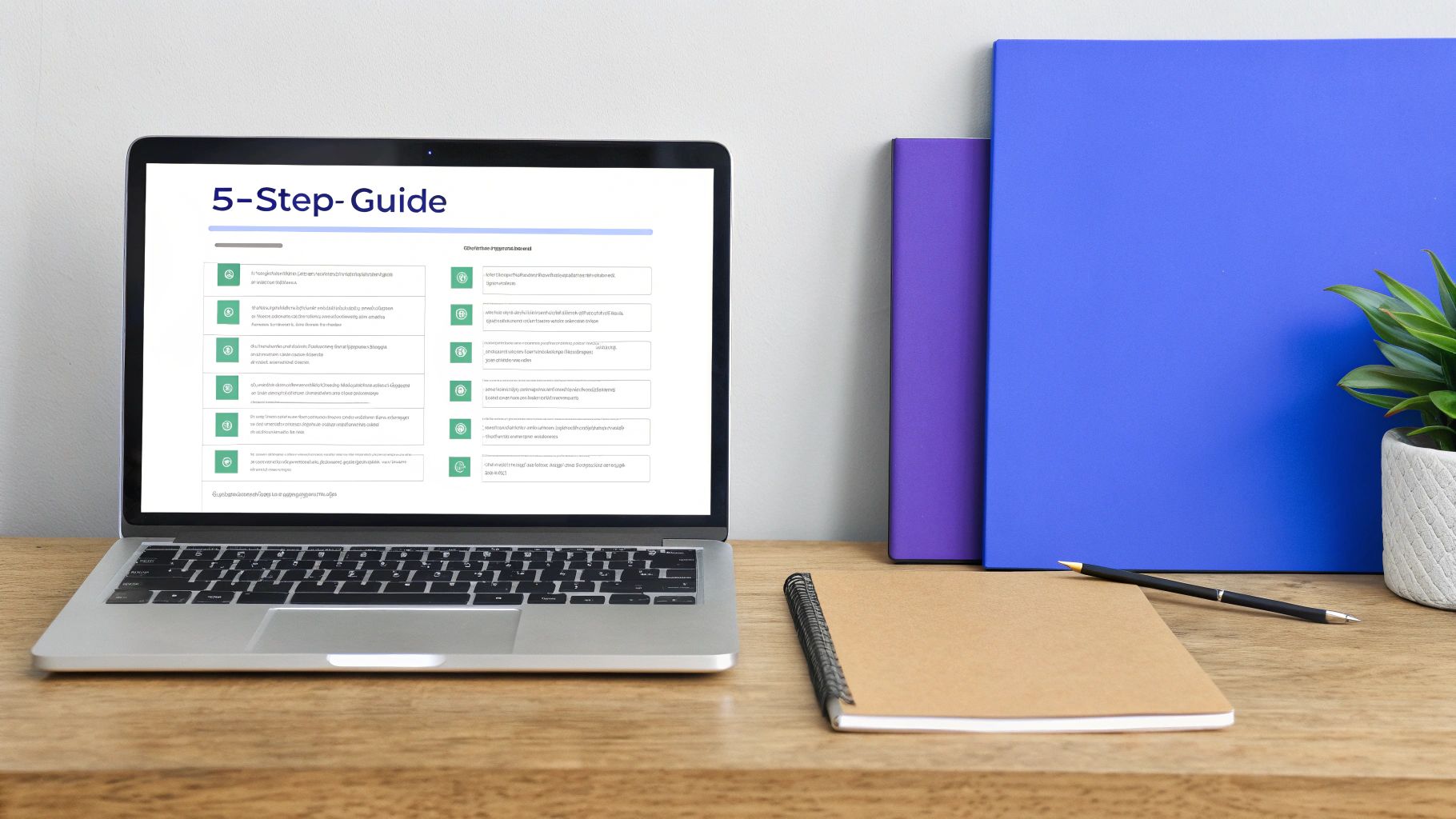
One of the biggest culprits is mismatched personal information. If your passport says "Robert," don't enter "Rob" on the form. Every detail you provide must match your official travel documents with 100% accuracy—we're talking every middle name, hyphen, and apostrophe. It’s amazing how often a simple transposed digit in a passport number leads to an instant denial.
This level of detail isn't surprising when you look at the bigger picture. The UK has been tightening its immigration rules, and precise compliance is more critical than ever. In fact, between April 2024 and March 2025, the UK Home Office reported a massive 40% drop in overall visa applications, a direct result of stricter eligibility criteria. You can read more about these recent changes in UK visa application trends.
Data Typos and Photo Problems
Beyond your name and passport number, all the data needs to make sense. It sounds obvious, but people in a rush often make simple mistakes with their travel dates, like entering an arrival date that’s already passed or a departure date that’s before they arrive.
The digital photo is another major hurdle. A non-compliant photo is one of the most common reasons for an application getting kicked back.
Here’s a quick checklist to avoid a photo failure:
- Bad Lighting: Make sure your photo is evenly lit. Photos that are too dark, have shadows across your face, or show a glare are instant rejections.
- Busy Background: The background has to be plain and light-coloured, like white or off-white. No pictures against patterned wallpaper or an outdoor scene.
- Hidden Face: Your full face must be completely visible. That means no sunglasses, no hats (unless for religious reasons), and making sure your hair isn’t covering your eyes.
A rejected application isn't just a delay—it means you have to start the whole process over and pay the fee again. To get it right the first time, you might consider a service like AssistEntry. Their experts can guide you through the whole thing, starting from just $79.
Don't Get Tripped Up by Security Questions
When you get to the security questions on the UK ETA form, complete honesty is non-negotiable. This section covers your criminal and immigration history. It might be tempting to omit a minor past offense or a previous visa refusal, but trying to hide something is far more damaging than just disclosing it.
UK authorities have access to extensive international databases, and if you provide false information, they will almost certainly find out. The consequence isn't just a rejection; you could face a multi-year ban from entering the country.
With so much on the line, getting a second pair of expert eyes on your application is a smart move. Application assistance providers like AssistEntry perform a full review to catch those small, easy-to-miss errors that automated systems are designed to reject. This simple step can dramatically boost your chances of getting approved on the first try, keeping your travel plans firmly on track.
So You've Hit Submit – What Now?
You’ve filled everything out, double-checked your details, and finally clicked that submit button. That moment can feel like a big sigh of relief, but it’s natural to wonder what’s happening behind the scenes.
Once submitted, your application zips over directly to the UK Home Office's systems. The good news is that the whole process is designed to be fast. Most people hear back within three working days, and it's not uncommon to get an approval email in just a few hours. This rapid turnaround is a world away from the old paper-based visa slog.
Getting the Good News: Your ETA Confirmation
When your ETA is approved, the confirmation will land directly in your email inbox—the one you used for the application. There’s no physical sticker or stamp to wait for in the mail.
This email is your proof of authorization. But what does that really mean? Your ETA isn't a document you carry; it's a digital permission slip electronically linked to your passport. When you check in for your flight, the airline staff will scan your passport, and their system will confirm your valid ETA. The UK Border Force will do the same thing when you land.
I always tell people to keep a digital copy of that confirmation email on their phone. Even better, print a copy and tuck it into your travel documents. It’s a simple backup that can save you a lot of headaches if you run into any tech issues on your travel day.
That waiting period, even if it's short, can be nerve-wracking. You start replaying every answer in your head, wondering if you made a mistake. This is why many travellers opt for an assistance service—they catch potential errors before you submit, so you can relax knowing your form is totally compliant.
What Happens If You Don't Hear Back (Or Get Bad News)?
While the system is usually efficient, delays can happen. If three days go by and your inbox is still empty, it likely means your application has been flagged for a manual review by a real person. This isn't a cause for immediate panic, but it is a perfect example of why you should never book non-refundable travel until you have that approved ETA.
On the rare occasion an ETA application is denied, you'll receive an email explaining the decision. A rejection doesn't mean you're banned from the UK. It usually just means you'll need to go through the more detailed process of applying for a standard Visitor Visa instead.
To sidestep the stress of delays or a potential rejection, a meticulous review of your application is non-negotiable. For peace of mind, you might consider using a service like AssistEntry. Starting from just $79, their experts walk you through everything, providing a full verification and error-checking service. It’s about getting the confidence that your application is perfect before it even lands on a government server.
Answering Your Top UK ETA Questions

Whenever a new travel system rolls out, questions are bound to follow. The UK ETA is no different, and a few key queries pop up constantly. Getting solid, clear answers to these is the best way to move forward with your travel plans without any lingering doubts.
One of the first things people want to know is how long their ETA is good for. Once approved, your UK ETA is valid for two years. This allows you to visit the UK multiple times for short stays—up to six months at a time. It covers tourism, visiting family, business trips, and even some short-term study. Just keep in mind that it doesn't permit you to work or claim public benefits in the UK.
What If I Make a Mistake?
This is a big one, and for good reason. What happens if you submit your application and then notice a typo?
Unfortunately, once an application is submitted, you can't go back and edit it. If you've made a critical error, like messing up your passport number, your only option is to submit a brand-new application and pay the fee again. This is exactly where using an expert service really proves its worth—they're trained to catch those small but costly mistakes before they become a problem.
Here are a few other common questions I hear all the time:
- Do I need to print it out? Nope. Your ETA is linked digitally to the passport you applied with. Still, I always recommend saving a digital copy of the approval email to your phone. It's just a smart backup to have on hand.
- What if my passport expires? The ETA is tied directly to the passport used in the application. If that passport expires, your ETA is no longer valid. You'll need to get a new ETA with your new passport details before you can travel.
An expert review service can save you from the headache of making a critical error. For a fee starting from just $79, a specialist will make sure your application is perfect, which boosts your approval odds and prevents last-minute travel disasters.
Why Use a Service Instead of Applying Directly?
While you can certainly apply through the official government portal, many travelers find that the peace of mind offered by an assistance service is well worth it. A third-party application assistance provider like AssistEntry essentially acts as your personal expert, running a full verification and error-checking on your application to make sure everything is compliant and correct before it’s sent off.
This kind of professional handling dramatically increases your chances of getting approved on the first try. It’s less about just filling out a form and more about making sure your travel plans are secure right from the start.
To avoid delays and common mistakes, let the experts at AssistEntry handle your UK ETA application. Their service includes a full review to ensure compliance and increase your chances of approval, with prices starting from just $79. Secure your travel authorization with confidence by visiting AssistEntry’s UK ETA page.
